Impact of Leadership Effectiveness on Employees: The Case of Amazon
VerifiedAdded on 2022/12/01
|47
|10220
|172
Report
AI Summary
This report, prepared for a BSc Business Management course, investigates the impact of leadership effectiveness on Amazon employees. It begins with an introduction to Amazon's leadership, particularly focusing on Jeff Bezos' transformational leadership style and its influence on employee engagement and company success. The report explores the background of the research, including key publications and themes such as transformational leadership, leader-member exchange theory, and the measurement of leadership effectiveness. It then presents the research hypothesis, aims, objectives, and questions, followed by a justification and contextualization of the study. The methodology section details the research paradigm, approach, data collection and analysis methods, sample size, target populations, equipment, ethical considerations, and limitations. The data analysis, findings, and discussion sections analyze the impact of leadership on employee motivation, satisfaction, and performance, highlighting both positive and negative impacts. Finally, the report provides recommendations and a conclusion summarizing the key findings and their implications for Amazon's leadership practices. The report utilizes various sources to support its analysis and provides a detailed overview of the research process and findings.
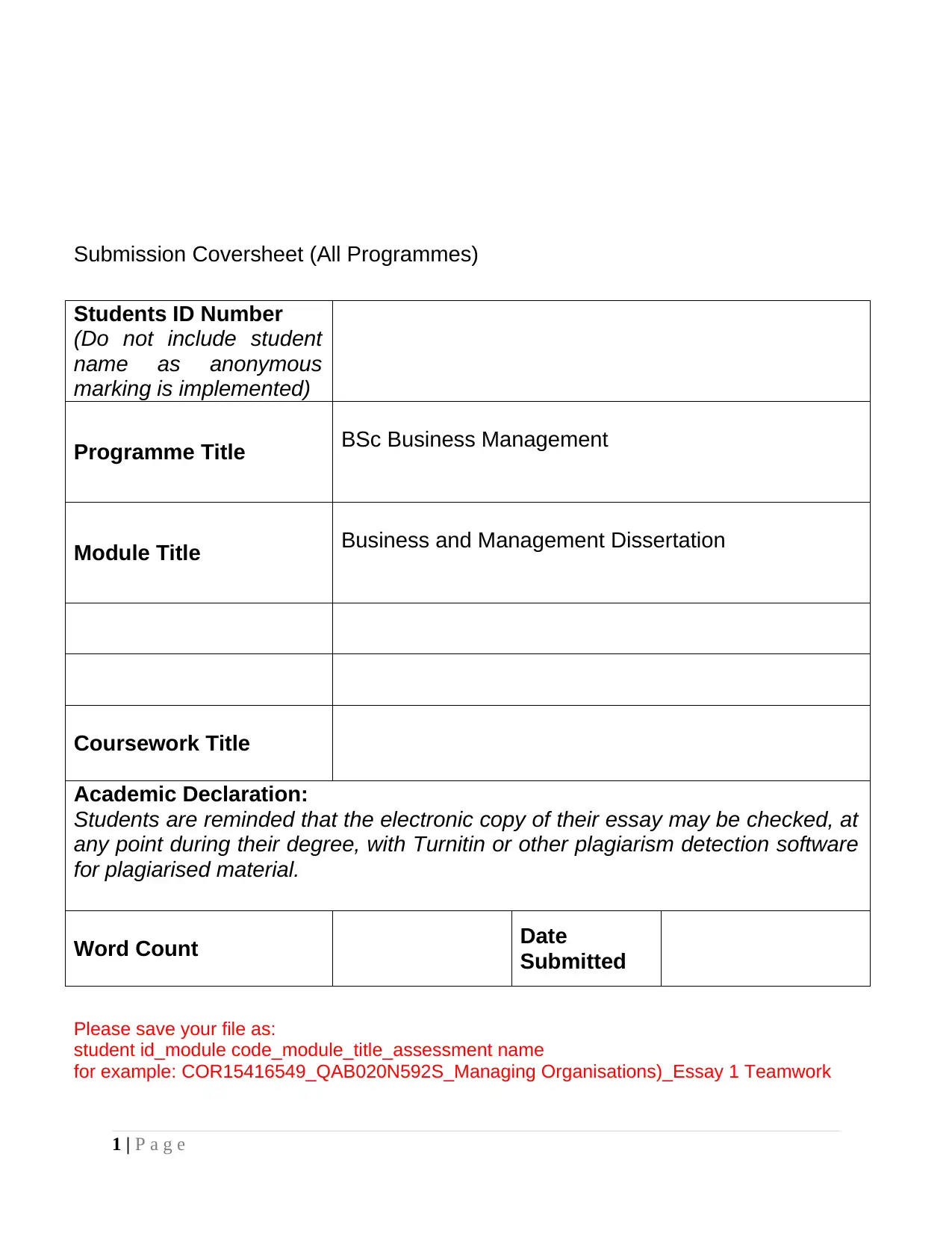
Submission Coversheet (All Programmes)
Students ID Number
(Do not include student
name as anonymous
marking is implemented)
Programme Title BSc Business Management
Module Title Business and Management Dissertation
Coursework Title
Academic Declaration:
Students are reminded that the electronic copy of their essay may be checked, at
any point during their degree, with Turnitin or other plagiarism detection software
for plagiarised material.
Word Count Date
Submitted
Please save your file as:
student id_module code_module_title_assessment name
for example: COR15416549_QAB020N592S_Managing Organisations)_Essay 1 Teamwork
1 | P a g e
Students ID Number
(Do not include student
name as anonymous
marking is implemented)
Programme Title BSc Business Management
Module Title Business and Management Dissertation
Coursework Title
Academic Declaration:
Students are reminded that the electronic copy of their essay may be checked, at
any point during their degree, with Turnitin or other plagiarism detection software
for plagiarised material.
Word Count Date
Submitted
Please save your file as:
student id_module code_module_title_assessment name
for example: COR15416549_QAB020N592S_Managing Organisations)_Essay 1 Teamwork
1 | P a g e
Paraphrase This Document
Need a fresh take? Get an instant paraphrase of this document with our AI Paraphraser
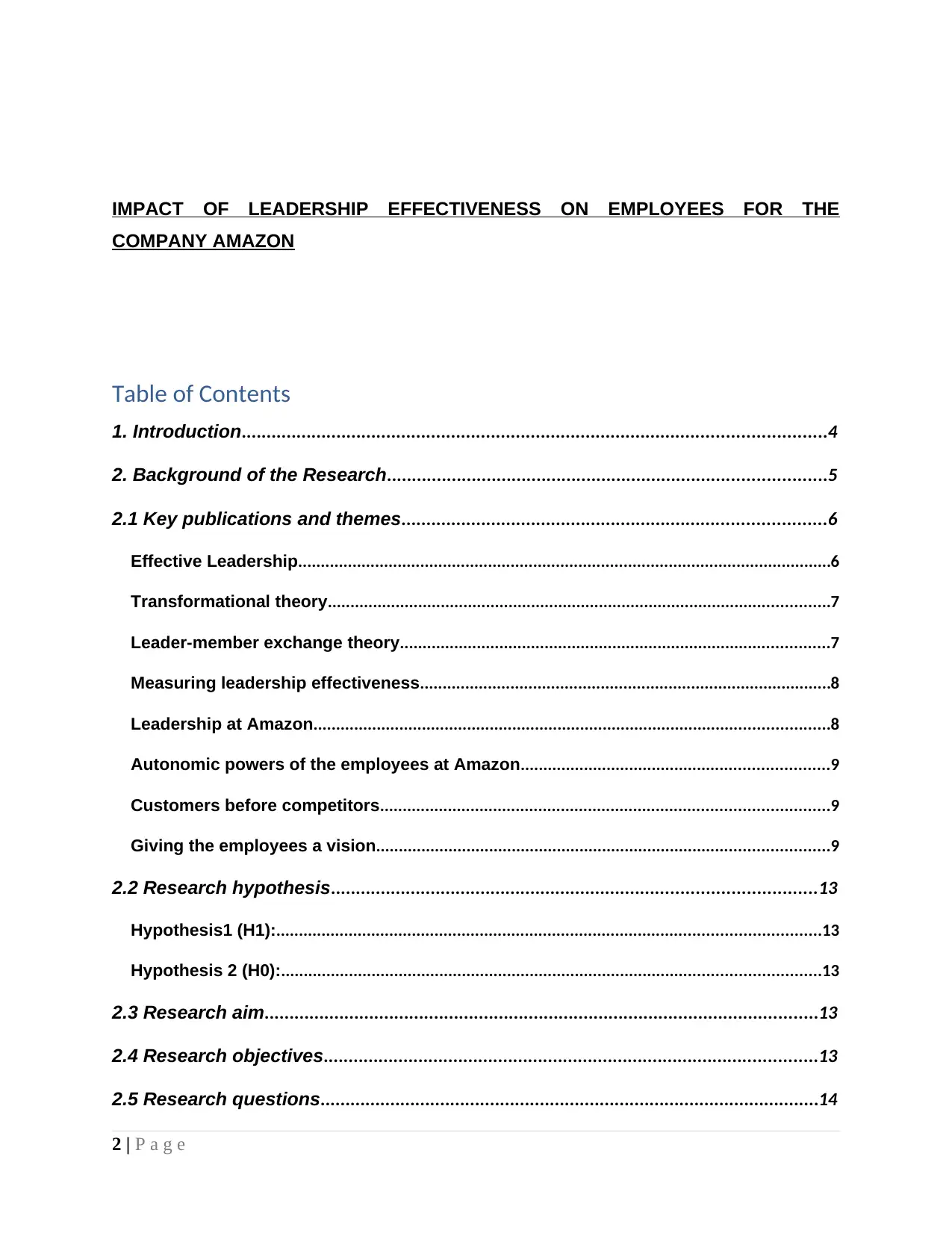
IMPACT OF LEADERSHIP EFFECTIVENESS ON EMPLOYEES FOR THE
COMPANY AMAZON
Table of Contents
1. Introduction.....................................................................................................................4
2. Background of the Research........................................................................................5
2.1 Key publications and themes.....................................................................................6
Effective Leadership......................................................................................................................6
Transformational theory...............................................................................................................7
Leader-member exchange theory...............................................................................................7
Measuring leadership effectiveness...........................................................................................8
Leadership at Amazon..................................................................................................................8
Autonomic powers of the employees at Amazon....................................................................9
Customers before competitors...................................................................................................9
Giving the employees a vision....................................................................................................9
2.2 Research hypothesis.................................................................................................13
Hypothesis1 (H1):........................................................................................................................13
Hypothesis 2 (H0):.......................................................................................................................13
2.3 Research aim...............................................................................................................13
2.4 Research objectives...................................................................................................13
2.5 Research questions....................................................................................................14
2 | P a g e
COMPANY AMAZON
Table of Contents
1. Introduction.....................................................................................................................4
2. Background of the Research........................................................................................5
2.1 Key publications and themes.....................................................................................6
Effective Leadership......................................................................................................................6
Transformational theory...............................................................................................................7
Leader-member exchange theory...............................................................................................7
Measuring leadership effectiveness...........................................................................................8
Leadership at Amazon..................................................................................................................8
Autonomic powers of the employees at Amazon....................................................................9
Customers before competitors...................................................................................................9
Giving the employees a vision....................................................................................................9
2.2 Research hypothesis.................................................................................................13
Hypothesis1 (H1):........................................................................................................................13
Hypothesis 2 (H0):.......................................................................................................................13
2.3 Research aim...............................................................................................................13
2.4 Research objectives...................................................................................................13
2.5 Research questions....................................................................................................14
2 | P a g e
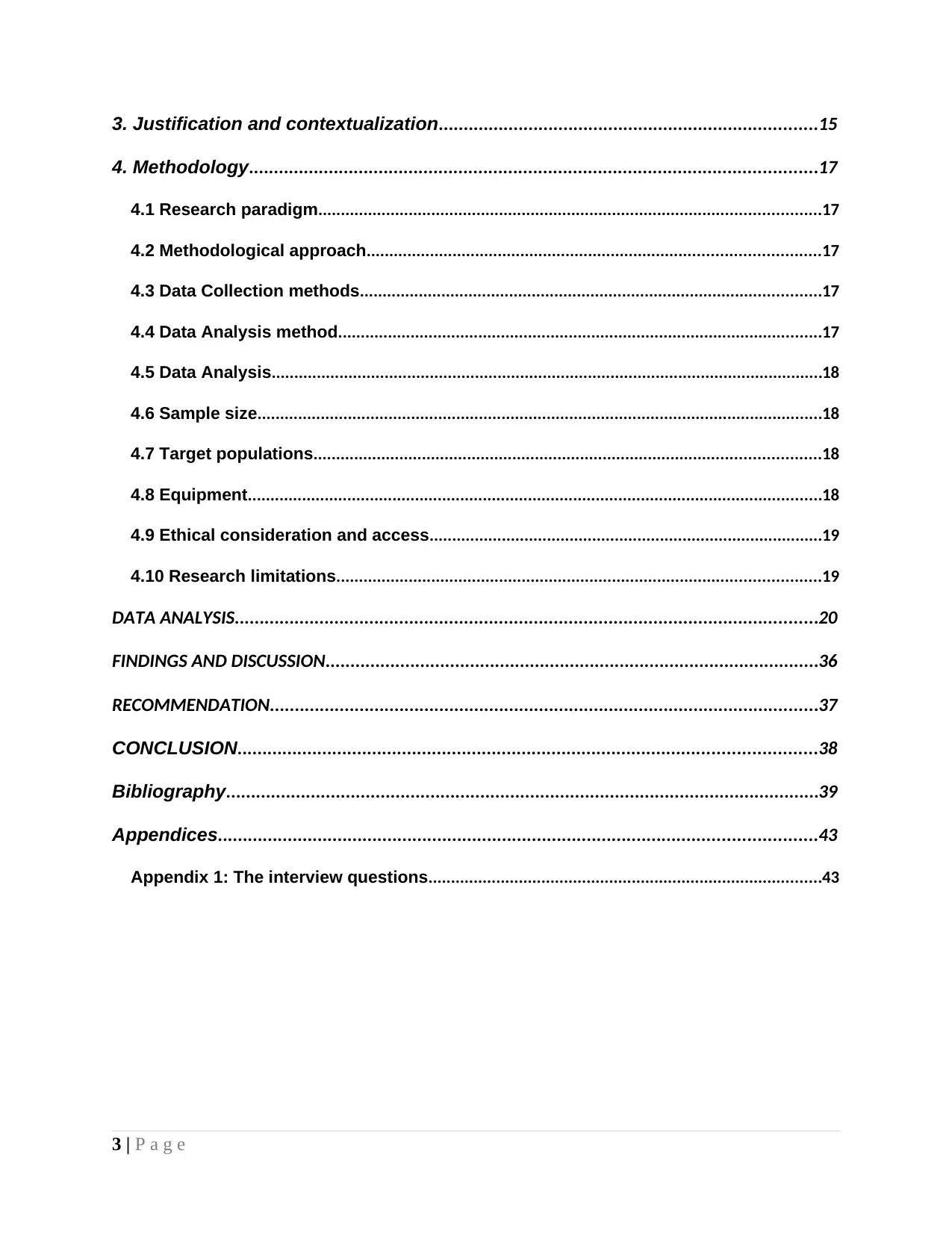
3. Justification and contextualization............................................................................15
4. Methodology..................................................................................................................17
4.1 Research paradigm...............................................................................................................17
4.2 Methodological approach....................................................................................................17
4.3 Data Collection methods......................................................................................................17
4.4 Data Analysis method...........................................................................................................17
4.5 Data Analysis..........................................................................................................................18
4.6 Sample size.............................................................................................................................18
4.7 Target populations................................................................................................................18
4.8 Equipment...............................................................................................................................18
4.9 Ethical consideration and access.......................................................................................19
4.10 Research limitations...........................................................................................................19
DATA ANALYSIS.....................................................................................................................20
FINDINGS AND DISCUSSION...................................................................................................36
RECOMMENDATION..............................................................................................................37
CONCLUSION....................................................................................................................38
Bibliography.......................................................................................................................39
Appendices........................................................................................................................43
Appendix 1: The interview questions.......................................................................................43
3 | P a g e
4. Methodology..................................................................................................................17
4.1 Research paradigm...............................................................................................................17
4.2 Methodological approach....................................................................................................17
4.3 Data Collection methods......................................................................................................17
4.4 Data Analysis method...........................................................................................................17
4.5 Data Analysis..........................................................................................................................18
4.6 Sample size.............................................................................................................................18
4.7 Target populations................................................................................................................18
4.8 Equipment...............................................................................................................................18
4.9 Ethical consideration and access.......................................................................................19
4.10 Research limitations...........................................................................................................19
DATA ANALYSIS.....................................................................................................................20
FINDINGS AND DISCUSSION...................................................................................................36
RECOMMENDATION..............................................................................................................37
CONCLUSION....................................................................................................................38
Bibliography.......................................................................................................................39
Appendices........................................................................................................................43
Appendix 1: The interview questions.......................................................................................43
3 | P a g e
⊘ This is a preview!⊘
Do you want full access?
Subscribe today to unlock all pages.

Trusted by 1+ million students worldwide
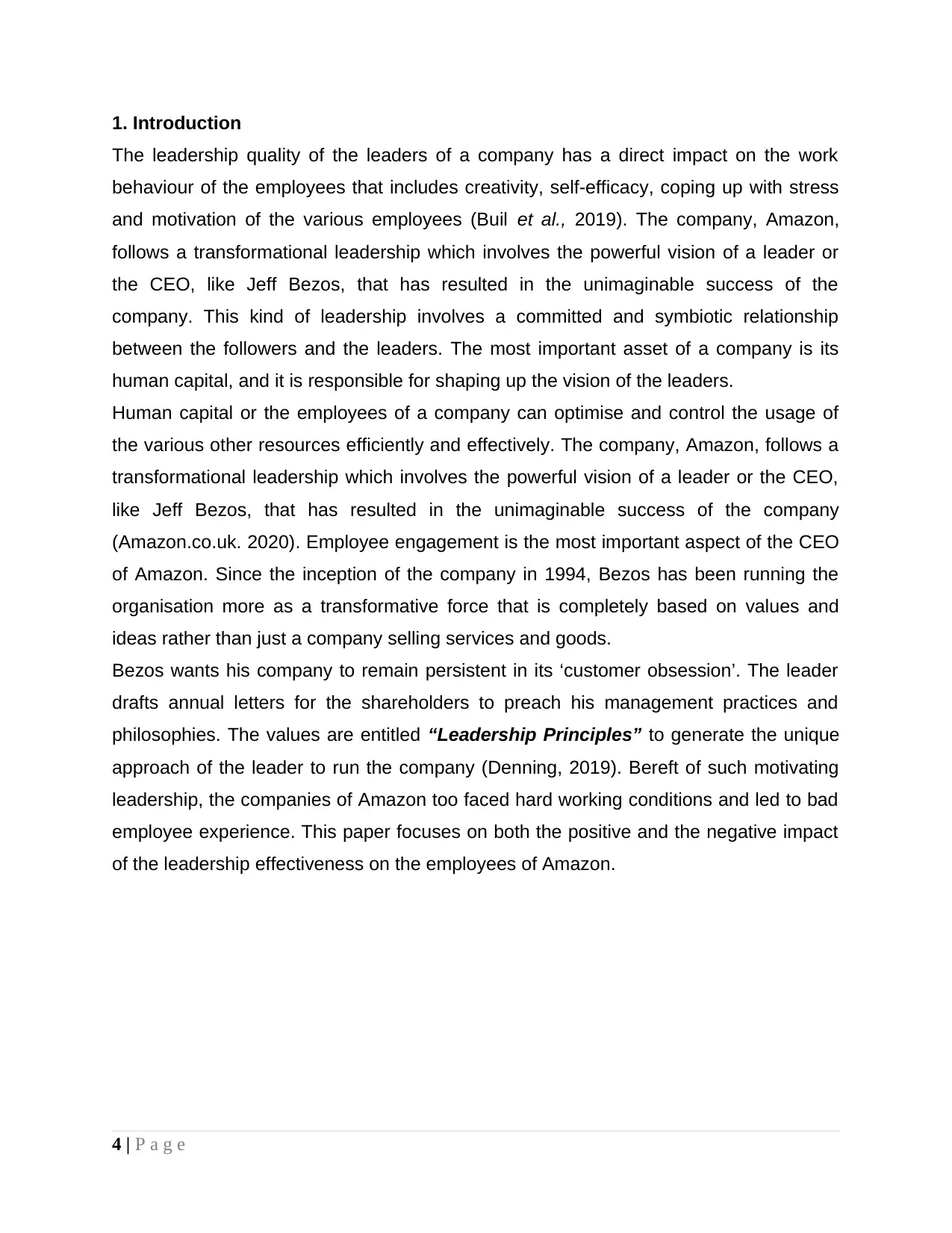
1. Introduction
The leadership quality of the leaders of a company has a direct impact on the work
behaviour of the employees that includes creativity, self-efficacy, coping up with stress
and motivation of the various employees (Buil et al., 2019). The company, Amazon,
follows a transformational leadership which involves the powerful vision of a leader or
the CEO, like Jeff Bezos, that has resulted in the unimaginable success of the
company. This kind of leadership involves a committed and symbiotic relationship
between the followers and the leaders. The most important asset of a company is its
human capital, and it is responsible for shaping up the vision of the leaders.
Human capital or the employees of a company can optimise and control the usage of
the various other resources efficiently and effectively. The company, Amazon, follows a
transformational leadership which involves the powerful vision of a leader or the CEO,
like Jeff Bezos, that has resulted in the unimaginable success of the company
(Amazon.co.uk. 2020). Employee engagement is the most important aspect of the CEO
of Amazon. Since the inception of the company in 1994, Bezos has been running the
organisation more as a transformative force that is completely based on values and
ideas rather than just a company selling services and goods.
Bezos wants his company to remain persistent in its ‘customer obsession’. The leader
drafts annual letters for the shareholders to preach his management practices and
philosophies. The values are entitled “Leadership Principles” to generate the unique
approach of the leader to run the company (Denning, 2019). Bereft of such motivating
leadership, the companies of Amazon too faced hard working conditions and led to bad
employee experience. This paper focuses on both the positive and the negative impact
of the leadership effectiveness on the employees of Amazon.
4 | P a g e
The leadership quality of the leaders of a company has a direct impact on the work
behaviour of the employees that includes creativity, self-efficacy, coping up with stress
and motivation of the various employees (Buil et al., 2019). The company, Amazon,
follows a transformational leadership which involves the powerful vision of a leader or
the CEO, like Jeff Bezos, that has resulted in the unimaginable success of the
company. This kind of leadership involves a committed and symbiotic relationship
between the followers and the leaders. The most important asset of a company is its
human capital, and it is responsible for shaping up the vision of the leaders.
Human capital or the employees of a company can optimise and control the usage of
the various other resources efficiently and effectively. The company, Amazon, follows a
transformational leadership which involves the powerful vision of a leader or the CEO,
like Jeff Bezos, that has resulted in the unimaginable success of the company
(Amazon.co.uk. 2020). Employee engagement is the most important aspect of the CEO
of Amazon. Since the inception of the company in 1994, Bezos has been running the
organisation more as a transformative force that is completely based on values and
ideas rather than just a company selling services and goods.
Bezos wants his company to remain persistent in its ‘customer obsession’. The leader
drafts annual letters for the shareholders to preach his management practices and
philosophies. The values are entitled “Leadership Principles” to generate the unique
approach of the leader to run the company (Denning, 2019). Bereft of such motivating
leadership, the companies of Amazon too faced hard working conditions and led to bad
employee experience. This paper focuses on both the positive and the negative impact
of the leadership effectiveness on the employees of Amazon.
4 | P a g e
Paraphrase This Document
Need a fresh take? Get an instant paraphrase of this document with our AI Paraphraser
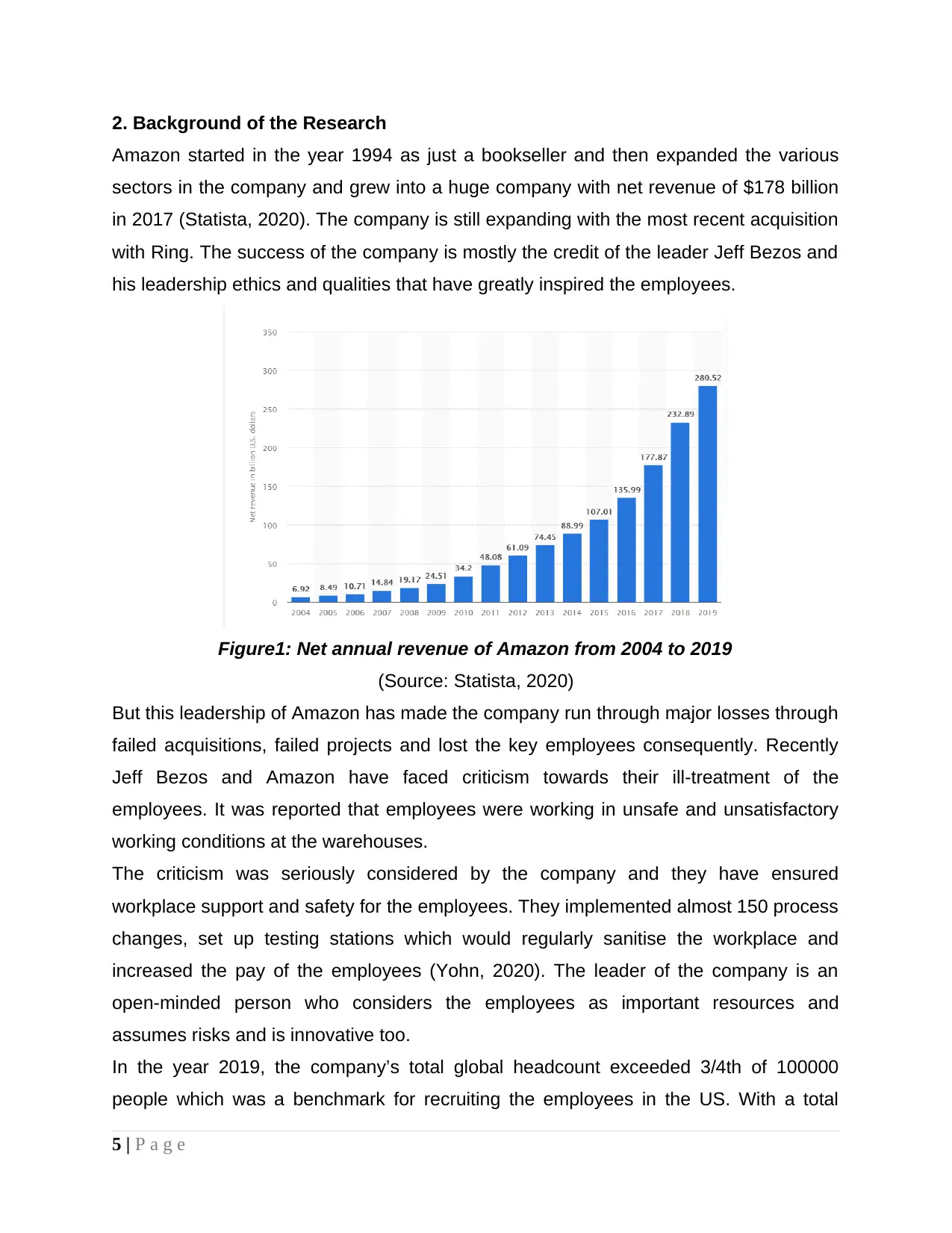
2. Background of the Research
Amazon started in the year 1994 as just a bookseller and then expanded the various
sectors in the company and grew into a huge company with net revenue of $178 billion
in 2017 (Statista, 2020). The company is still expanding with the most recent acquisition
with Ring. The success of the company is mostly the credit of the leader Jeff Bezos and
his leadership ethics and qualities that have greatly inspired the employees.
Figure1: Net annual revenue of Amazon from 2004 to 2019
(Source: Statista, 2020)
But this leadership of Amazon has made the company run through major losses through
failed acquisitions, failed projects and lost the key employees consequently. Recently
Jeff Bezos and Amazon have faced criticism towards their ill-treatment of the
employees. It was reported that employees were working in unsafe and unsatisfactory
working conditions at the warehouses.
The criticism was seriously considered by the company and they have ensured
workplace support and safety for the employees. They implemented almost 150 process
changes, set up testing stations which would regularly sanitise the workplace and
increased the pay of the employees (Yohn, 2020). The leader of the company is an
open-minded person who considers the employees as important resources and
assumes risks and is innovative too.
In the year 2019, the company’s total global headcount exceeded 3/4th of 100000
people which was a benchmark for recruiting the employees in the US. With a total
5 | P a g e
Amazon started in the year 1994 as just a bookseller and then expanded the various
sectors in the company and grew into a huge company with net revenue of $178 billion
in 2017 (Statista, 2020). The company is still expanding with the most recent acquisition
with Ring. The success of the company is mostly the credit of the leader Jeff Bezos and
his leadership ethics and qualities that have greatly inspired the employees.
Figure1: Net annual revenue of Amazon from 2004 to 2019
(Source: Statista, 2020)
But this leadership of Amazon has made the company run through major losses through
failed acquisitions, failed projects and lost the key employees consequently. Recently
Jeff Bezos and Amazon have faced criticism towards their ill-treatment of the
employees. It was reported that employees were working in unsafe and unsatisfactory
working conditions at the warehouses.
The criticism was seriously considered by the company and they have ensured
workplace support and safety for the employees. They implemented almost 150 process
changes, set up testing stations which would regularly sanitise the workplace and
increased the pay of the employees (Yohn, 2020). The leader of the company is an
open-minded person who considers the employees as important resources and
assumes risks and is innovative too.
In the year 2019, the company’s total global headcount exceeded 3/4th of 100000
people which was a benchmark for recruiting the employees in the US. With a total
5 | P a g e
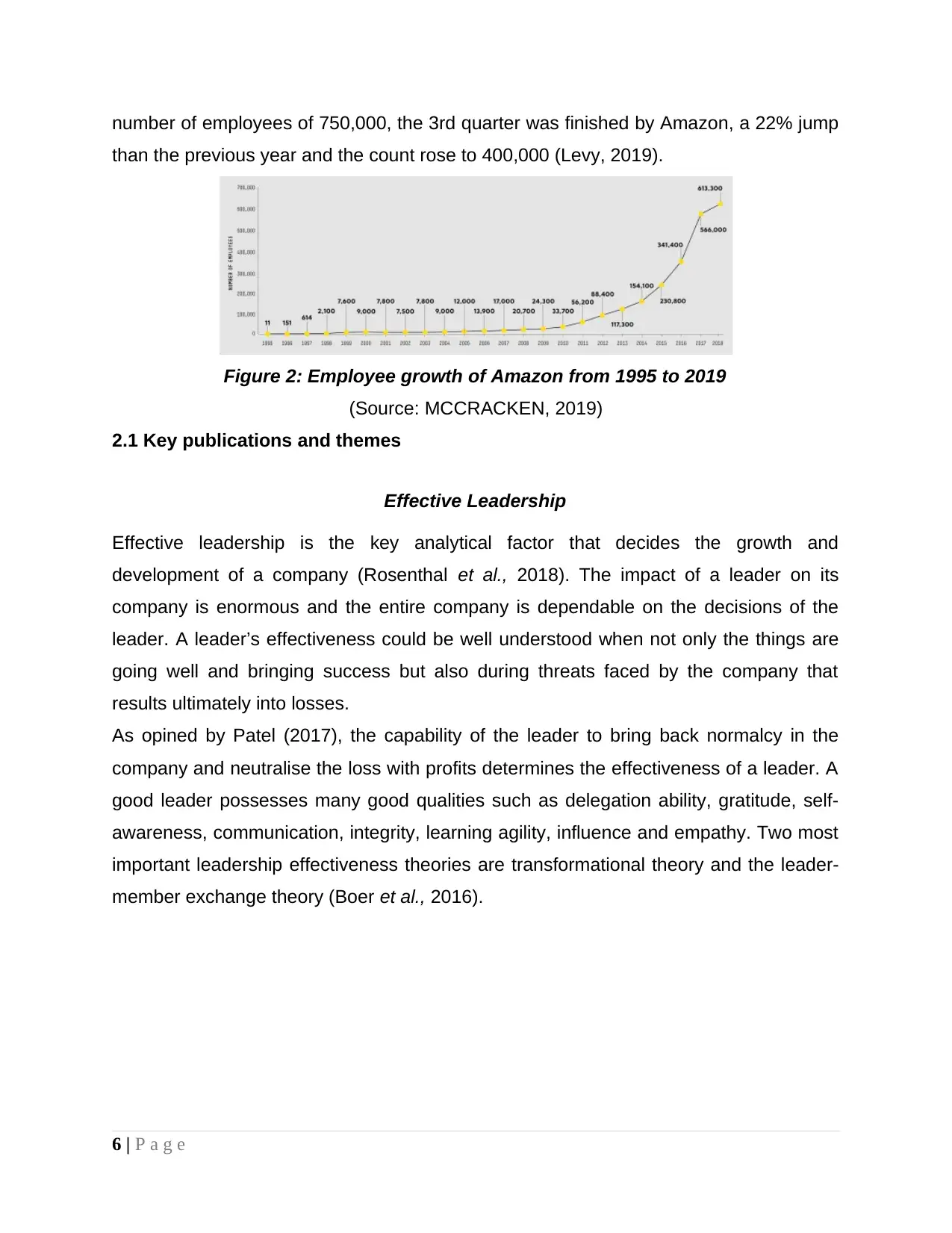
number of employees of 750,000, the 3rd quarter was finished by Amazon, a 22% jump
than the previous year and the count rose to 400,000 (Levy, 2019).
Figure 2: Employee growth of Amazon from 1995 to 2019
(Source: MCCRACKEN, 2019)
2.1 Key publications and themes
Effective Leadership
Effective leadership is the key analytical factor that decides the growth and
development of a company (Rosenthal et al., 2018). The impact of a leader on its
company is enormous and the entire company is dependable on the decisions of the
leader. A leader’s effectiveness could be well understood when not only the things are
going well and bringing success but also during threats faced by the company that
results ultimately into losses.
As opined by Patel (2017), the capability of the leader to bring back normalcy in the
company and neutralise the loss with profits determines the effectiveness of a leader. A
good leader possesses many good qualities such as delegation ability, gratitude, self-
awareness, communication, integrity, learning agility, influence and empathy. Two most
important leadership effectiveness theories are transformational theory and the leader-
member exchange theory (Boer et al., 2016).
6 | P a g e
than the previous year and the count rose to 400,000 (Levy, 2019).
Figure 2: Employee growth of Amazon from 1995 to 2019
(Source: MCCRACKEN, 2019)
2.1 Key publications and themes
Effective Leadership
Effective leadership is the key analytical factor that decides the growth and
development of a company (Rosenthal et al., 2018). The impact of a leader on its
company is enormous and the entire company is dependable on the decisions of the
leader. A leader’s effectiveness could be well understood when not only the things are
going well and bringing success but also during threats faced by the company that
results ultimately into losses.
As opined by Patel (2017), the capability of the leader to bring back normalcy in the
company and neutralise the loss with profits determines the effectiveness of a leader. A
good leader possesses many good qualities such as delegation ability, gratitude, self-
awareness, communication, integrity, learning agility, influence and empathy. Two most
important leadership effectiveness theories are transformational theory and the leader-
member exchange theory (Boer et al., 2016).
6 | P a g e
⊘ This is a preview!⊘
Do you want full access?
Subscribe today to unlock all pages.

Trusted by 1+ million students worldwide
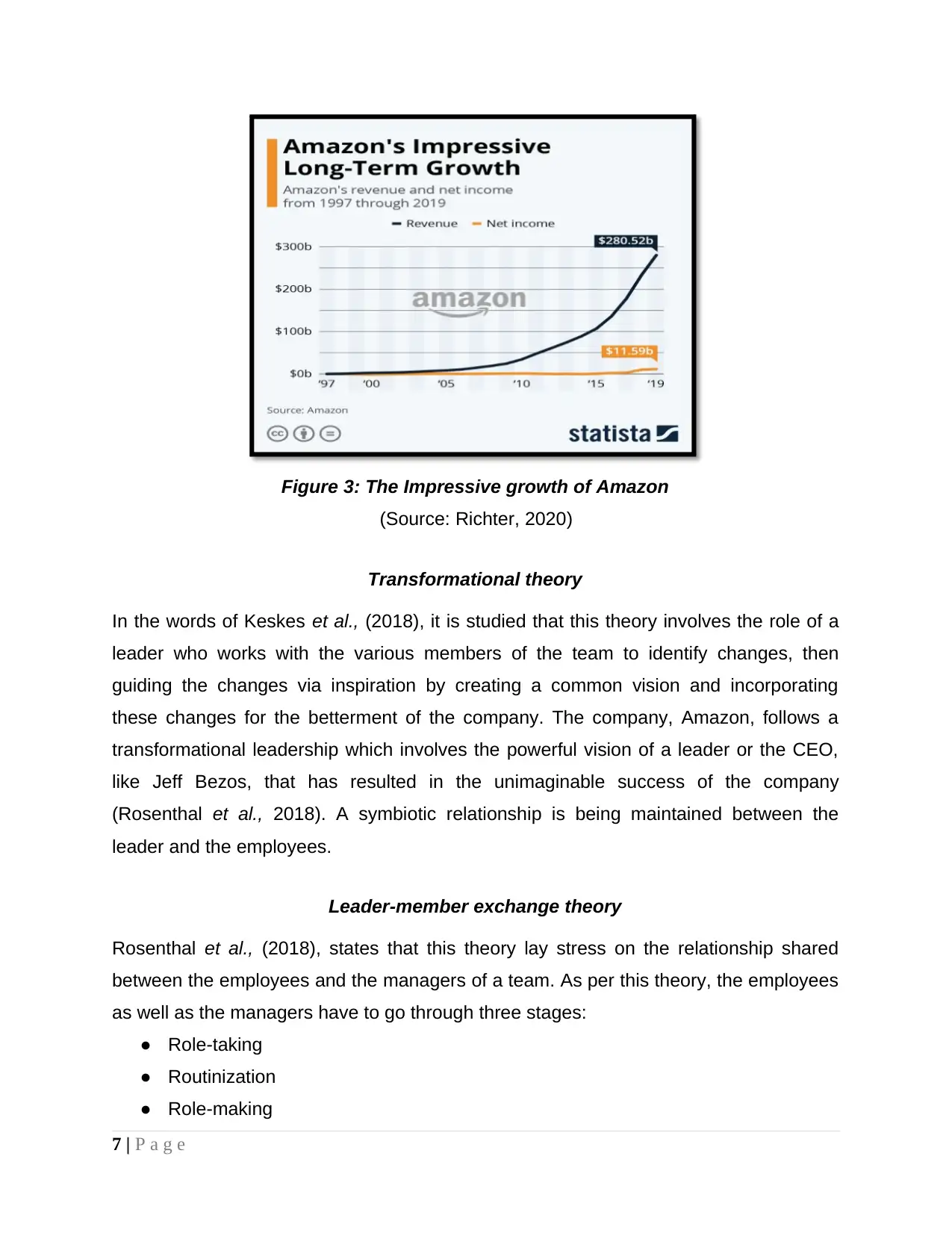
Figure 3: The Impressive growth of Amazon
(Source: Richter, 2020)
Transformational theory
In the words of Keskes et al., (2018), it is studied that this theory involves the role of a
leader who works with the various members of the team to identify changes, then
guiding the changes via inspiration by creating a common vision and incorporating
these changes for the betterment of the company. The company, Amazon, follows a
transformational leadership which involves the powerful vision of a leader or the CEO,
like Jeff Bezos, that has resulted in the unimaginable success of the company
(Rosenthal et al., 2018). A symbiotic relationship is being maintained between the
leader and the employees.
Leader-member exchange theory
Rosenthal et al., (2018), states that this theory lay stress on the relationship shared
between the employees and the managers of a team. As per this theory, the employees
as well as the managers have to go through three stages:
● Role-taking
● Routinization
● Role-making
7 | P a g e
(Source: Richter, 2020)
Transformational theory
In the words of Keskes et al., (2018), it is studied that this theory involves the role of a
leader who works with the various members of the team to identify changes, then
guiding the changes via inspiration by creating a common vision and incorporating
these changes for the betterment of the company. The company, Amazon, follows a
transformational leadership which involves the powerful vision of a leader or the CEO,
like Jeff Bezos, that has resulted in the unimaginable success of the company
(Rosenthal et al., 2018). A symbiotic relationship is being maintained between the
leader and the employees.
Leader-member exchange theory
Rosenthal et al., (2018), states that this theory lay stress on the relationship shared
between the employees and the managers of a team. As per this theory, the employees
as well as the managers have to go through three stages:
● Role-taking
● Routinization
● Role-making
7 | P a g e
Paraphrase This Document
Need a fresh take? Get an instant paraphrase of this document with our AI Paraphraser
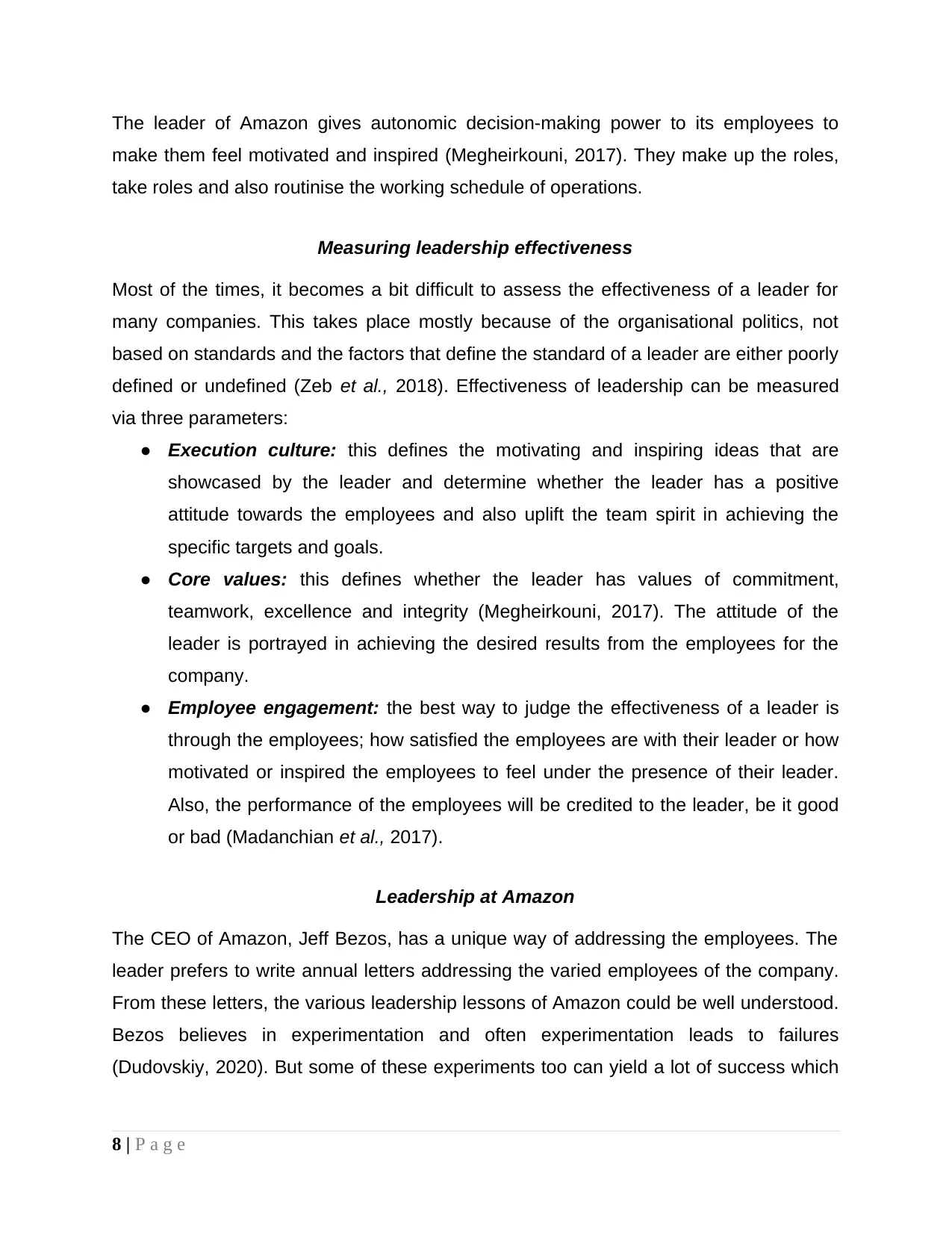
The leader of Amazon gives autonomic decision-making power to its employees to
make them feel motivated and inspired (Megheirkouni, 2017). They make up the roles,
take roles and also routinise the working schedule of operations.
Measuring leadership effectiveness
Most of the times, it becomes a bit difficult to assess the effectiveness of a leader for
many companies. This takes place mostly because of the organisational politics, not
based on standards and the factors that define the standard of a leader are either poorly
defined or undefined (Zeb et al., 2018). Effectiveness of leadership can be measured
via three parameters:
● Execution culture: this defines the motivating and inspiring ideas that are
showcased by the leader and determine whether the leader has a positive
attitude towards the employees and also uplift the team spirit in achieving the
specific targets and goals.
● Core values: this defines whether the leader has values of commitment,
teamwork, excellence and integrity (Megheirkouni, 2017). The attitude of the
leader is portrayed in achieving the desired results from the employees for the
company.
● Employee engagement: the best way to judge the effectiveness of a leader is
through the employees; how satisfied the employees are with their leader or how
motivated or inspired the employees to feel under the presence of their leader.
Also, the performance of the employees will be credited to the leader, be it good
or bad (Madanchian et al., 2017).
Leadership at Amazon
The CEO of Amazon, Jeff Bezos, has a unique way of addressing the employees. The
leader prefers to write annual letters addressing the varied employees of the company.
From these letters, the various leadership lessons of Amazon could be well understood.
Bezos believes in experimentation and often experimentation leads to failures
(Dudovskiy, 2020). But some of these experiments too can yield a lot of success which
8 | P a g e
make them feel motivated and inspired (Megheirkouni, 2017). They make up the roles,
take roles and also routinise the working schedule of operations.
Measuring leadership effectiveness
Most of the times, it becomes a bit difficult to assess the effectiveness of a leader for
many companies. This takes place mostly because of the organisational politics, not
based on standards and the factors that define the standard of a leader are either poorly
defined or undefined (Zeb et al., 2018). Effectiveness of leadership can be measured
via three parameters:
● Execution culture: this defines the motivating and inspiring ideas that are
showcased by the leader and determine whether the leader has a positive
attitude towards the employees and also uplift the team spirit in achieving the
specific targets and goals.
● Core values: this defines whether the leader has values of commitment,
teamwork, excellence and integrity (Megheirkouni, 2017). The attitude of the
leader is portrayed in achieving the desired results from the employees for the
company.
● Employee engagement: the best way to judge the effectiveness of a leader is
through the employees; how satisfied the employees are with their leader or how
motivated or inspired the employees to feel under the presence of their leader.
Also, the performance of the employees will be credited to the leader, be it good
or bad (Madanchian et al., 2017).
Leadership at Amazon
The CEO of Amazon, Jeff Bezos, has a unique way of addressing the employees. The
leader prefers to write annual letters addressing the varied employees of the company.
From these letters, the various leadership lessons of Amazon could be well understood.
Bezos believes in experimentation and often experimentation leads to failures
(Dudovskiy, 2020). But some of these experiments too can yield a lot of success which
8 | P a g e
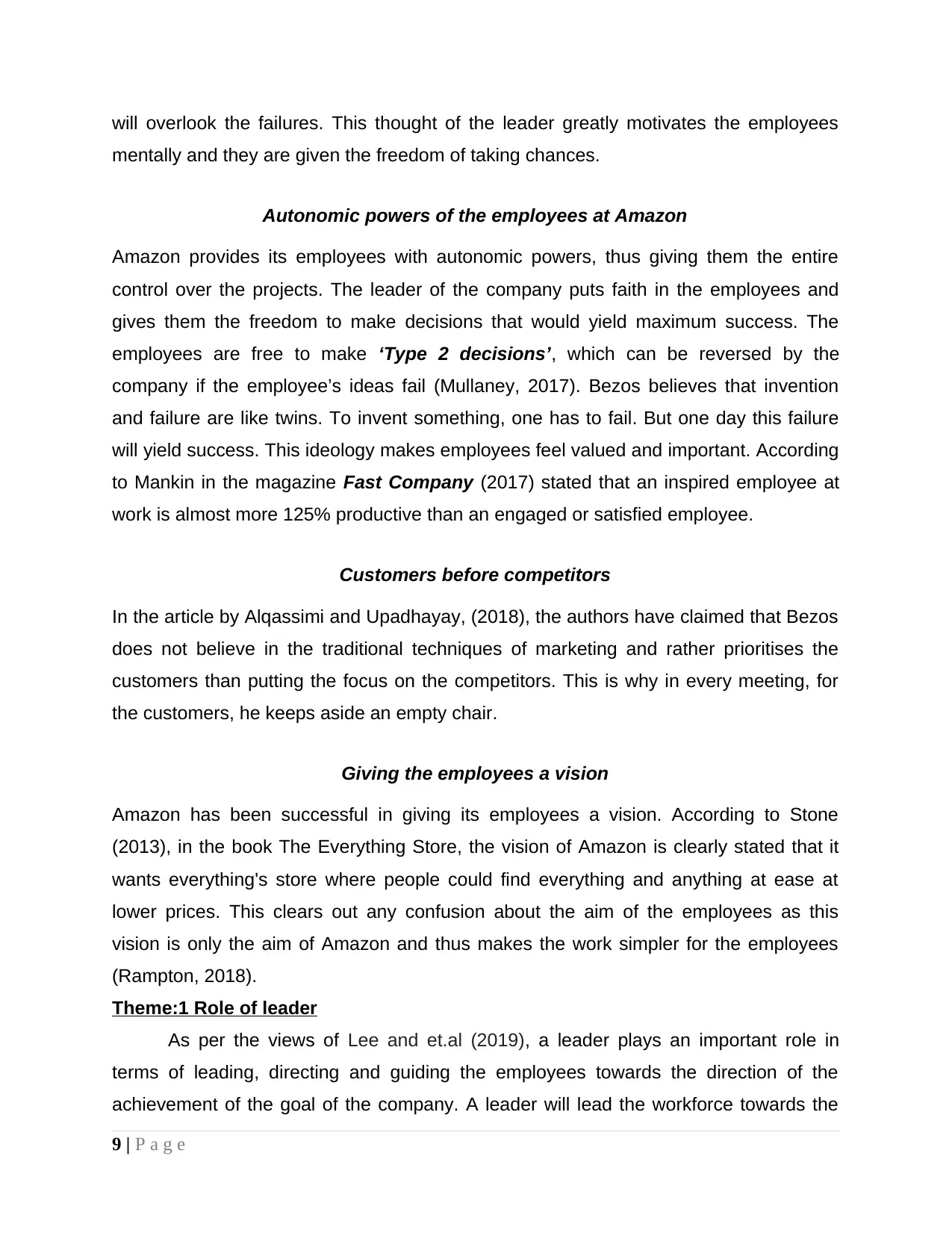
will overlook the failures. This thought of the leader greatly motivates the employees
mentally and they are given the freedom of taking chances.
Autonomic powers of the employees at Amazon
Amazon provides its employees with autonomic powers, thus giving them the entire
control over the projects. The leader of the company puts faith in the employees and
gives them the freedom to make decisions that would yield maximum success. The
employees are free to make ‘Type 2 decisions’, which can be reversed by the
company if the employee’s ideas fail (Mullaney, 2017). Bezos believes that invention
and failure are like twins. To invent something, one has to fail. But one day this failure
will yield success. This ideology makes employees feel valued and important. According
to Mankin in the magazine Fast Company (2017) stated that an inspired employee at
work is almost more 125% productive than an engaged or satisfied employee.
Customers before competitors
In the article by Alqassimi and Upadhayay, (2018), the authors have claimed that Bezos
does not believe in the traditional techniques of marketing and rather prioritises the
customers than putting the focus on the competitors. This is why in every meeting, for
the customers, he keeps aside an empty chair.
Giving the employees a vision
Amazon has been successful in giving its employees a vision. According to Stone
(2013), in the book The Everything Store, the vision of Amazon is clearly stated that it
wants everything's store where people could find everything and anything at ease at
lower prices. This clears out any confusion about the aim of the employees as this
vision is only the aim of Amazon and thus makes the work simpler for the employees
(Rampton, 2018).
Theme:1 Role of leader
As per the views of Lee and et.al (2019), a leader plays an important role in
terms of leading, directing and guiding the employees towards the direction of the
achievement of the goal of the company. A leader will lead the workforce towards the
9 | P a g e
mentally and they are given the freedom of taking chances.
Autonomic powers of the employees at Amazon
Amazon provides its employees with autonomic powers, thus giving them the entire
control over the projects. The leader of the company puts faith in the employees and
gives them the freedom to make decisions that would yield maximum success. The
employees are free to make ‘Type 2 decisions’, which can be reversed by the
company if the employee’s ideas fail (Mullaney, 2017). Bezos believes that invention
and failure are like twins. To invent something, one has to fail. But one day this failure
will yield success. This ideology makes employees feel valued and important. According
to Mankin in the magazine Fast Company (2017) stated that an inspired employee at
work is almost more 125% productive than an engaged or satisfied employee.
Customers before competitors
In the article by Alqassimi and Upadhayay, (2018), the authors have claimed that Bezos
does not believe in the traditional techniques of marketing and rather prioritises the
customers than putting the focus on the competitors. This is why in every meeting, for
the customers, he keeps aside an empty chair.
Giving the employees a vision
Amazon has been successful in giving its employees a vision. According to Stone
(2013), in the book The Everything Store, the vision of Amazon is clearly stated that it
wants everything's store where people could find everything and anything at ease at
lower prices. This clears out any confusion about the aim of the employees as this
vision is only the aim of Amazon and thus makes the work simpler for the employees
(Rampton, 2018).
Theme:1 Role of leader
As per the views of Lee and et.al (2019), a leader plays an important role in
terms of leading, directing and guiding the employees towards the direction of the
achievement of the goal of the company. A leader will lead the workforce towards the
9 | P a g e
⊘ This is a preview!⊘
Do you want full access?
Subscribe today to unlock all pages.

Trusted by 1+ million students worldwide
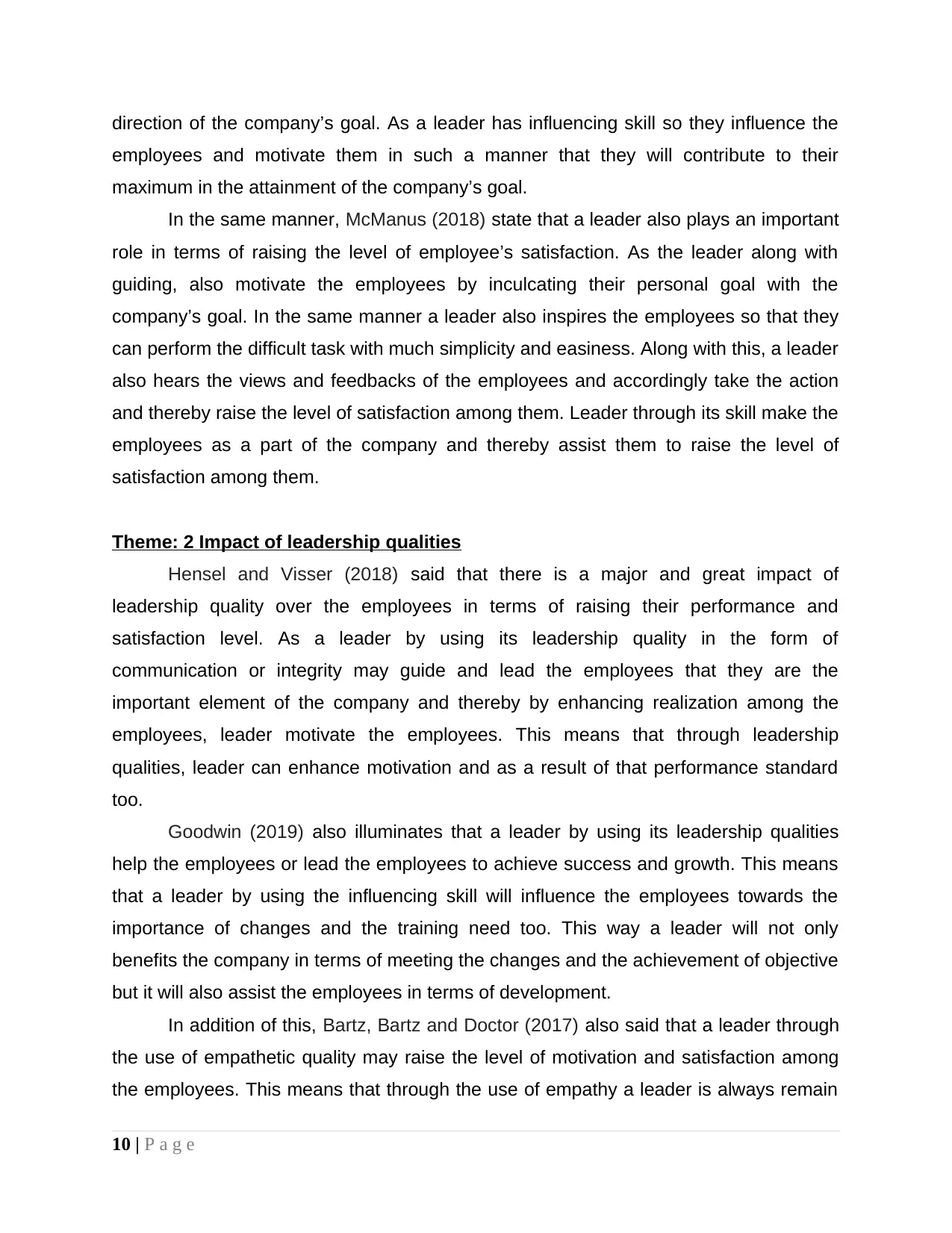
direction of the company’s goal. As a leader has influencing skill so they influence the
employees and motivate them in such a manner that they will contribute to their
maximum in the attainment of the company’s goal.
In the same manner, McManus (2018) state that a leader also plays an important
role in terms of raising the level of employee’s satisfaction. As the leader along with
guiding, also motivate the employees by inculcating their personal goal with the
company’s goal. In the same manner a leader also inspires the employees so that they
can perform the difficult task with much simplicity and easiness. Along with this, a leader
also hears the views and feedbacks of the employees and accordingly take the action
and thereby raise the level of satisfaction among them. Leader through its skill make the
employees as a part of the company and thereby assist them to raise the level of
satisfaction among them.
Theme: 2 Impact of leadership qualities
Hensel and Visser (2018) said that there is a major and great impact of
leadership quality over the employees in terms of raising their performance and
satisfaction level. As a leader by using its leadership quality in the form of
communication or integrity may guide and lead the employees that they are the
important element of the company and thereby by enhancing realization among the
employees, leader motivate the employees. This means that through leadership
qualities, leader can enhance motivation and as a result of that performance standard
too.
Goodwin (2019) also illuminates that a leader by using its leadership qualities
help the employees or lead the employees to achieve success and growth. This means
that a leader by using the influencing skill will influence the employees towards the
importance of changes and the training need too. This way a leader will not only
benefits the company in terms of meeting the changes and the achievement of objective
but it will also assist the employees in terms of development.
In addition of this, Bartz, Bartz and Doctor (2017) also said that a leader through
the use of empathetic quality may raise the level of motivation and satisfaction among
the employees. This means that through the use of empathy a leader is always remain
10 | P a g e
employees and motivate them in such a manner that they will contribute to their
maximum in the attainment of the company’s goal.
In the same manner, McManus (2018) state that a leader also plays an important
role in terms of raising the level of employee’s satisfaction. As the leader along with
guiding, also motivate the employees by inculcating their personal goal with the
company’s goal. In the same manner a leader also inspires the employees so that they
can perform the difficult task with much simplicity and easiness. Along with this, a leader
also hears the views and feedbacks of the employees and accordingly take the action
and thereby raise the level of satisfaction among them. Leader through its skill make the
employees as a part of the company and thereby assist them to raise the level of
satisfaction among them.
Theme: 2 Impact of leadership qualities
Hensel and Visser (2018) said that there is a major and great impact of
leadership quality over the employees in terms of raising their performance and
satisfaction level. As a leader by using its leadership quality in the form of
communication or integrity may guide and lead the employees that they are the
important element of the company and thereby by enhancing realization among the
employees, leader motivate the employees. This means that through leadership
qualities, leader can enhance motivation and as a result of that performance standard
too.
Goodwin (2019) also illuminates that a leader by using its leadership qualities
help the employees or lead the employees to achieve success and growth. This means
that a leader by using the influencing skill will influence the employees towards the
importance of changes and the training need too. This way a leader will not only
benefits the company in terms of meeting the changes and the achievement of objective
but it will also assist the employees in terms of development.
In addition of this, Bartz, Bartz and Doctor (2017) also said that a leader through
the use of empathetic quality may raise the level of motivation and satisfaction among
the employees. This means that through the use of empathy a leader is always remain
10 | P a g e
Paraphrase This Document
Need a fresh take? Get an instant paraphrase of this document with our AI Paraphraser
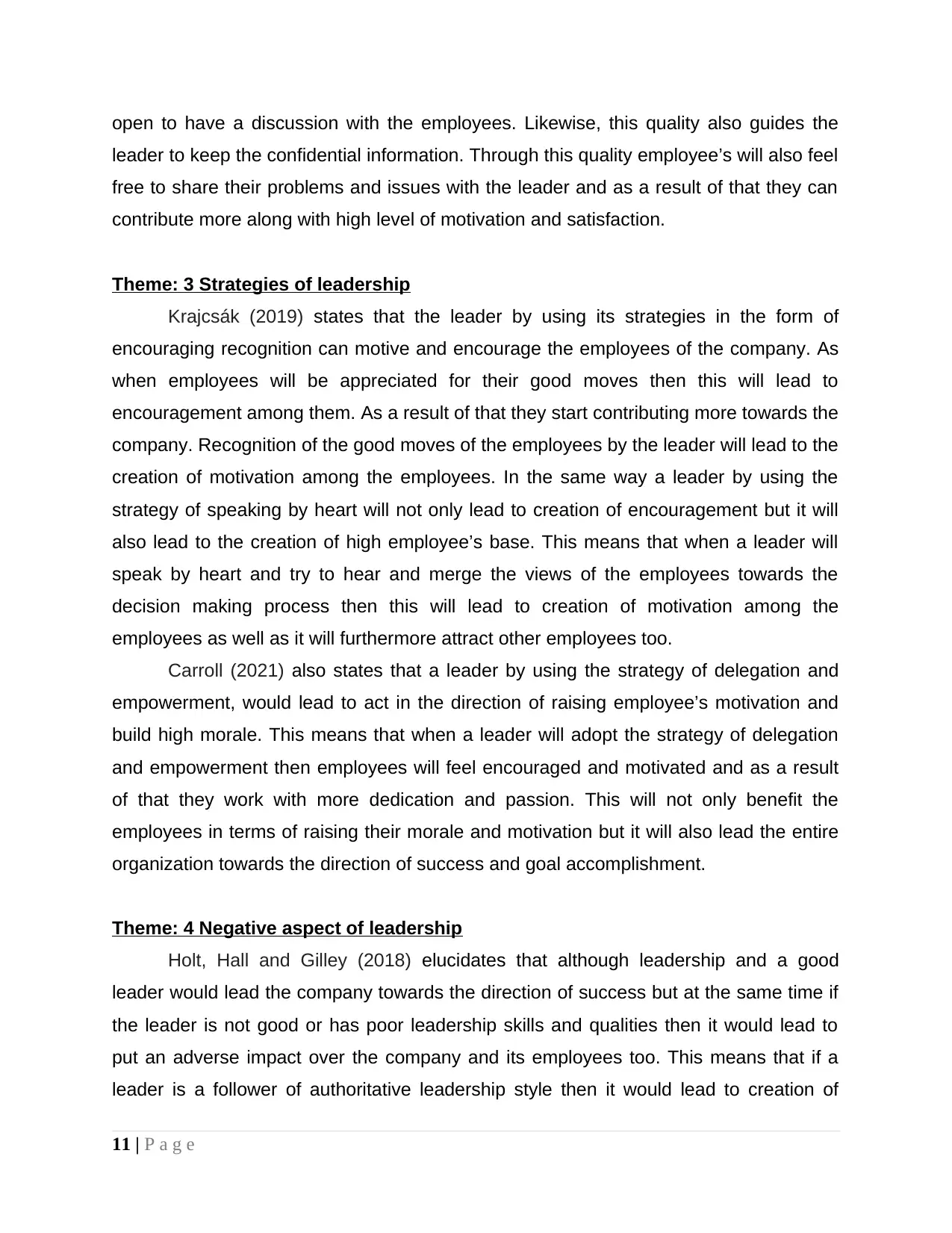
open to have a discussion with the employees. Likewise, this quality also guides the
leader to keep the confidential information. Through this quality employee’s will also feel
free to share their problems and issues with the leader and as a result of that they can
contribute more along with high level of motivation and satisfaction.
Theme: 3 Strategies of leadership
Krajcsák (2019) states that the leader by using its strategies in the form of
encouraging recognition can motive and encourage the employees of the company. As
when employees will be appreciated for their good moves then this will lead to
encouragement among them. As a result of that they start contributing more towards the
company. Recognition of the good moves of the employees by the leader will lead to the
creation of motivation among the employees. In the same way a leader by using the
strategy of speaking by heart will not only lead to creation of encouragement but it will
also lead to the creation of high employee’s base. This means that when a leader will
speak by heart and try to hear and merge the views of the employees towards the
decision making process then this will lead to creation of motivation among the
employees as well as it will furthermore attract other employees too.
Carroll (2021) also states that a leader by using the strategy of delegation and
empowerment, would lead to act in the direction of raising employee’s motivation and
build high morale. This means that when a leader will adopt the strategy of delegation
and empowerment then employees will feel encouraged and motivated and as a result
of that they work with more dedication and passion. This will not only benefit the
employees in terms of raising their morale and motivation but it will also lead the entire
organization towards the direction of success and goal accomplishment.
Theme: 4 Negative aspect of leadership
Holt, Hall and Gilley (2018) elucidates that although leadership and a good
leader would lead the company towards the direction of success but at the same time if
the leader is not good or has poor leadership skills and qualities then it would lead to
put an adverse impact over the company and its employees too. This means that if a
leader is a follower of authoritative leadership style then it would lead to creation of
11 | P a g e
leader to keep the confidential information. Through this quality employee’s will also feel
free to share their problems and issues with the leader and as a result of that they can
contribute more along with high level of motivation and satisfaction.
Theme: 3 Strategies of leadership
Krajcsák (2019) states that the leader by using its strategies in the form of
encouraging recognition can motive and encourage the employees of the company. As
when employees will be appreciated for their good moves then this will lead to
encouragement among them. As a result of that they start contributing more towards the
company. Recognition of the good moves of the employees by the leader will lead to the
creation of motivation among the employees. In the same way a leader by using the
strategy of speaking by heart will not only lead to creation of encouragement but it will
also lead to the creation of high employee’s base. This means that when a leader will
speak by heart and try to hear and merge the views of the employees towards the
decision making process then this will lead to creation of motivation among the
employees as well as it will furthermore attract other employees too.
Carroll (2021) also states that a leader by using the strategy of delegation and
empowerment, would lead to act in the direction of raising employee’s motivation and
build high morale. This means that when a leader will adopt the strategy of delegation
and empowerment then employees will feel encouraged and motivated and as a result
of that they work with more dedication and passion. This will not only benefit the
employees in terms of raising their morale and motivation but it will also lead the entire
organization towards the direction of success and goal accomplishment.
Theme: 4 Negative aspect of leadership
Holt, Hall and Gilley (2018) elucidates that although leadership and a good
leader would lead the company towards the direction of success but at the same time if
the leader is not good or has poor leadership skills and qualities then it would lead to
put an adverse impact over the company and its employees too. This means that if a
leader is a follower of authoritative leadership style then it would lead to creation of
11 | P a g e
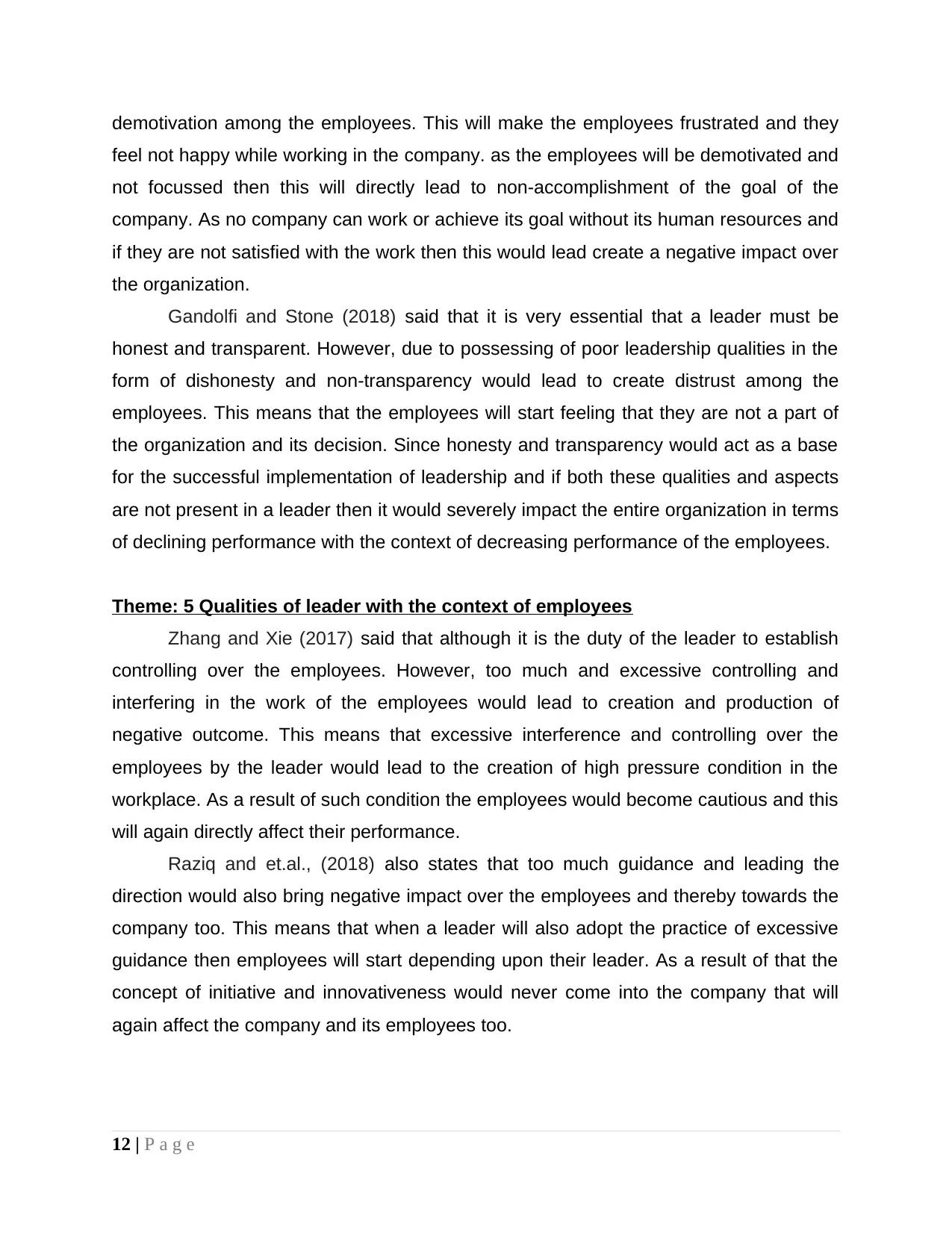
demotivation among the employees. This will make the employees frustrated and they
feel not happy while working in the company. as the employees will be demotivated and
not focussed then this will directly lead to non-accomplishment of the goal of the
company. As no company can work or achieve its goal without its human resources and
if they are not satisfied with the work then this would lead create a negative impact over
the organization.
Gandolfi and Stone (2018) said that it is very essential that a leader must be
honest and transparent. However, due to possessing of poor leadership qualities in the
form of dishonesty and non-transparency would lead to create distrust among the
employees. This means that the employees will start feeling that they are not a part of
the organization and its decision. Since honesty and transparency would act as a base
for the successful implementation of leadership and if both these qualities and aspects
are not present in a leader then it would severely impact the entire organization in terms
of declining performance with the context of decreasing performance of the employees.
Theme: 5 Qualities of leader with the context of employees
Zhang and Xie (2017) said that although it is the duty of the leader to establish
controlling over the employees. However, too much and excessive controlling and
interfering in the work of the employees would lead to creation and production of
negative outcome. This means that excessive interference and controlling over the
employees by the leader would lead to the creation of high pressure condition in the
workplace. As a result of such condition the employees would become cautious and this
will again directly affect their performance.
Raziq and et.al., (2018) also states that too much guidance and leading the
direction would also bring negative impact over the employees and thereby towards the
company too. This means that when a leader will also adopt the practice of excessive
guidance then employees will start depending upon their leader. As a result of that the
concept of initiative and innovativeness would never come into the company that will
again affect the company and its employees too.
12 | P a g e
feel not happy while working in the company. as the employees will be demotivated and
not focussed then this will directly lead to non-accomplishment of the goal of the
company. As no company can work or achieve its goal without its human resources and
if they are not satisfied with the work then this would lead create a negative impact over
the organization.
Gandolfi and Stone (2018) said that it is very essential that a leader must be
honest and transparent. However, due to possessing of poor leadership qualities in the
form of dishonesty and non-transparency would lead to create distrust among the
employees. This means that the employees will start feeling that they are not a part of
the organization and its decision. Since honesty and transparency would act as a base
for the successful implementation of leadership and if both these qualities and aspects
are not present in a leader then it would severely impact the entire organization in terms
of declining performance with the context of decreasing performance of the employees.
Theme: 5 Qualities of leader with the context of employees
Zhang and Xie (2017) said that although it is the duty of the leader to establish
controlling over the employees. However, too much and excessive controlling and
interfering in the work of the employees would lead to creation and production of
negative outcome. This means that excessive interference and controlling over the
employees by the leader would lead to the creation of high pressure condition in the
workplace. As a result of such condition the employees would become cautious and this
will again directly affect their performance.
Raziq and et.al., (2018) also states that too much guidance and leading the
direction would also bring negative impact over the employees and thereby towards the
company too. This means that when a leader will also adopt the practice of excessive
guidance then employees will start depending upon their leader. As a result of that the
concept of initiative and innovativeness would never come into the company that will
again affect the company and its employees too.
12 | P a g e
⊘ This is a preview!⊘
Do you want full access?
Subscribe today to unlock all pages.

Trusted by 1+ million students worldwide
1 out of 47
Related Documents
Your All-in-One AI-Powered Toolkit for Academic Success.
+13062052269
info@desklib.com
Available 24*7 on WhatsApp / Email
![[object Object]](/_next/static/media/star-bottom.7253800d.svg)
Unlock your academic potential
Copyright © 2020–2025 A2Z Services. All Rights Reserved. Developed and managed by ZUCOL.




